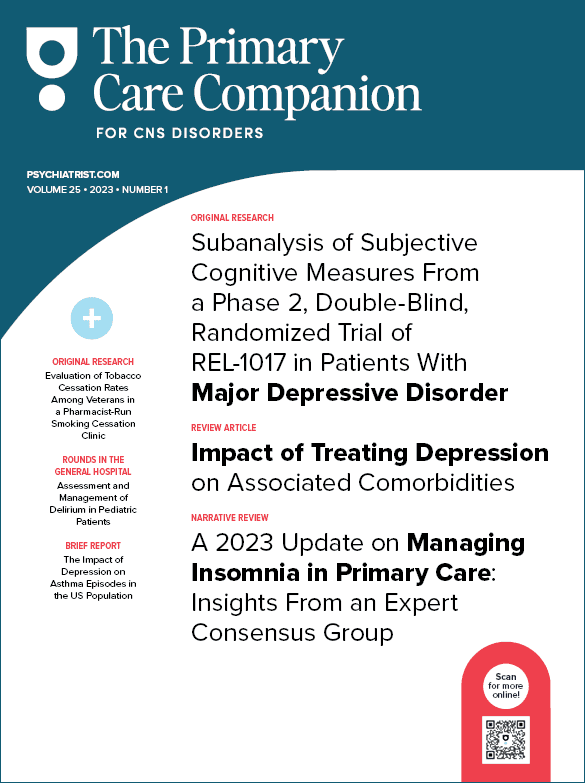
Prim Care Companion CNS Disord 2022;24(1):21cr02947
To cite: Lagman JG, Tucker J, Koons C, et al. A case of psychosis in an adolescent male using CBD keif nugs. Prim Care Companion CNS Disord. 2022;24(1):21cr02947.
To share: https://doi.org/10.4088/PCC.21cr02947
© Copyright 2021 Physicians Postgraduate Press, Inc.
aDepartment of Psychiatry and Behavioral Health, Penn State University College of Medicine, Hershey Pennsylvania
bPenn State University College of Medicine, Hershey Pennsylvania
cTower Health Reading Hospital, Reading, Pennsylvania
*Corresponding author: Jasmin G. Lagman, MD, Department of Psychiatry and Behavioral Health, Penn State University College of Medicine, 500 University Drive, MC, Hershey, PA 17033 ([email protected]).
The use of recreational cannabis in children and adolescents is not supported by the medical community. Evidence has shown increased risk of early-onset psychotic disorder for those who have used cannabis during adolescence, especially those who have preexisting risk factors and are frequent users.1 The 2 most represented phytocannabinoids in Cannabis sativa plants are cannabidiol (CBD) and tetrahydrocannabinol (THC).2 The latter is considered the main psychoactive ingredient of cannabis, while the former is supposed to be nonintoxicating and nonpsychoactive.3–5 Hemp, a cannabis plant, was legalized under the 2018 Farm Bill, requiring that the THC threshold be less than 0.3% of dry weight.6 Hemp is not used for psychoactive purposes due to its low levels of THC.7 With its various unspecified health advantages, CBD is the compound of highest interest from all hemp constituents.8 Since CBD and THC have contrasting effects, it is important to ensure the purity of CBD. We present the case of a 17-year-old male teenager who developed psychosis after smoking an advertised CBD product.
Case Report
The 17-year-old male patient presented to the inpatient psychiatry unit for increased mood lability and perceptual disturbance described as distortions in lights and objects. Recently, he was vaping “CBD keif nugs” purchased online, consuming 6 grams of this product at least 2 weeks prior to this admission. He reported avoiding any psychoactive (THC) cannabis use, as it had caused some paranoia symptoms in the past. The urine drug screen was positive for metabolites of THC. His past psychiatric history was significant for hallucinogen-induced psychosis requiring inpatient treatment a year ago, associated with aggression, paranoia, and hallucinations. There had been no hallucinations for more than 8 months, and the patient was maintained only on a selective serotonin reuptake inhibitor for anxiety in the past 5 months. A month prior to this admission, he started to exhibit increased anxiety, aggression, and paranoia after an untreated dental problem. He was started on a low dose of clonazepam to address his behavioral symptoms, but it was not helpful. Three weeks prior to admission, he was started on chlorpromazine with no improvement in symptoms, and, eventually, the patient was hospitalized. At the time of hospitalization, he endorsed hearing voices, seeing lights and visual movements, and paranoia. He was started on olanzapine with reduction in hallucinations within days after admission. He was discharged to follow-up at an outpatient drug and alcohol treatment facility.
Discussion
Keif nugs or keifs are resin glands containing terpenes and cannabinoids that make cannabis.9 While CBD has not clearly been linked to psychosis, in cases when it is made from the hemp flower such as that found in keif nugs, it can contain 47.8% of CBD and less than 0.3% of THC. However, when large quantities of CBD in this form are used consistently, patients can unknowingly consume high doses of THC concurrently. An amount of 10–20 mg is considered high and can lead to intoxication.8 Our patient was using 6 mg of hemp flower, which could mean that he was consuming up to 18 mg of THC a day, explaining the positive urine drug screen. In addition, there is a high rate of mislabeling and lack of standardization in the online marketplace for CBD products.10 Some online markets overlabel the CBD content and underlabel the THC content. Underlabeling CBD does not have serious adverse consequences at high doses, but higher THC content may be enough to cause impairment and intoxication, especially in the pediatric population.11 It is important for providers and consumers to be aware that the use of hemp plants, even if within the federal limits, can cause intoxication if used in excessive amounts.
Published online: December 30, 2021.
Potential conflicts of interest: None.
Funding/support: None.
Previous presentation: This case was presented as a poster at the virtual American Psychiatric Association Annual Meeting; May 2, 2021.
Patient consent: Consent was received from both the patient and parent to publish this case report, and information has been de-identified to protect anonymity.
References (11)

- Bagot KS, Milin R, Kaminer Y. Adolescent initiation of cannabis use and early-onset psychosis. Subst Abus. 2015;36(4):524–533. PubMed CrossRef
- Bonaccorso S, Ricciardi A, Zangani C, et al. Cannabidiol (CBD) use in psychiatric disorders: a systematic review. Neurotoxicology. 2019;74:282–298. PubMed CrossRef
- Davies C, Bhattacharyya S. Cannabidiol as a potential treatment for psychosis. Ther Adv Psychopharmacol. 2019;9:2045125319881916. PubMed CrossRef
- ElSohly MA, Radwan MM, Gul W, et al. Phytochemistry of Cannabis sativa L. Prog Chem Org Nat Prod. 2017;103:1–36. PubMed
- VanDolah HJ, Bauer BA, Mauck KF. Clinicians’ guide to cannabidiol and hemp oils. Mayo Clin Proc. 2019;94(9):1840–1851. PubMed CrossRef
- Mead A. Legal and regulatory issues governing cannabis and cannabis-derived products in the United States. Front Plant Sci. 2019;10:697. PubMed CrossRef
- Ammerman S, Ryan S, Adelman WP; Committee on Substance Abuse, the Committee on Adolescence. The impact of marijuana policies on youth: clinical, research, and legal update. Pediatrics. 2015;135(3):e769–e785. PubMed CrossRef
- Lachenmeier DW, Habel S, Fischer B, et al. Are adverse effects of cannabidiol (CBD) products caused by tetrahydrocannabinol (THC) contamination? F1000 Res. 2019;8:1394. PubMed CrossRef
- Berg CJ, Henriksen L, Cavazos-Rehg P, et al. The development and pilot testing of the Marijuana Retail Surveillance Tool (MRST): assessing marketing and point-of-sale practices among recreational marijuana retailers. Health Educ Res. 2017;32(6):465–472. PubMed CrossRef
- Freedman DA, Patel AD. Inadequate regulation contributes to mislabeled online cannabidiol products. Pediatr Neurol Briefs. 2018;32:3. PubMed CrossRef
- Bonn-Miller MO, Loflin MJE, Thomas BF, et al. Labeling accuracy of cannabidiol extracts sold online. JAMA. 2017;318(17):1708–1709. PubMed CrossRef
Enjoy free PDF downloads as part of your membership!
Save
Cite
Advertisement
GAM ID: sidebar-top




